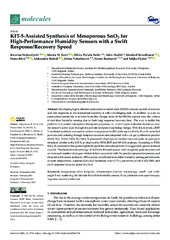Приказ основних података о документу
KIT-5-Assisted Synthesis of Mesoporous SnO2 for High-Performance Humidity Sensors with a Swift Response/Recovery Speed
| dc.creator | Vojisavljević, Katarina | |
| dc.creator | Savić, Slavica | |
| dc.creator | Počuča-Nešić, Milica | |
| dc.creator | Hodžić, Aden | |
| dc.creator | Kriechbaum, Manfred | |
| dc.creator | Ribić, Vesna | |
| dc.creator | Rečnik, Aleksander | |
| dc.creator | Vukašinović, Jelena | |
| dc.creator | Branković, Goran | |
| dc.creator | Đokić, Veljko | |
| dc.date.accessioned | 2023-02-27T11:26:16Z | |
| dc.date.available | 2023-02-27T11:26:16Z | |
| dc.date.issued | 2023 | |
| dc.identifier.issn | 1420-3049 | |
| dc.identifier.uri | http://TechnoRep.tmf.bg.ac.rs/handle/123456789/5919 | |
| dc.description.abstract | Developing highly efficient semiconductor metal oxide (SMOX) sensors capable of accurate and fast responses to environmental humidity is still a challenging task. In addition to a not so pronounced sensitivity to relative humidity change, most of the SMOXs cannot meet the criteria of real-time humidity sensing due to their long response/recovery time. The way to tackle this problem is to control adsorption/desorption processes, i.e., water-vapor molecular dynamics, over the sensor’s active layer through the powder and pore morphology design. With this in mind, a KIT-5-mediated synthesis was used to achieve mesoporous tin (IV) oxide replica (SnO2-R) with controlled pore size and ordering through template inversion and compared with a sol-gel synthesized powder (SnO2-SG). Unlike SnO2-SG, SnO2-R possessed a high specific surface area and quite an open pore structure, similar to the KIT-5, as observed by TEM, BET and SWAXS analyses. According to TEM, SnO2-R consisted of fine-grained globular particles and some percent of exaggerated, grown twinned crystals. The distinctive morphology of the SnO2-R-based sensor, with its specific pore structure and an increased number of oxygen-related defects associated with the powder preparation process and detected at the sensor surface by XPS analysis, contributed to excellent humidity sensing performances at room temperature, comprised of a low hysteresis error (3.7%), sensitivity of 406.8 kΩ/RH% and swift response/recovery speed (4 s/6 s). | sr |
| dc.language.iso | en | sr |
| dc.publisher | MDPI | sr |
| dc.relation | info:eu-repo/grantAgreement/MESTD/inst-2020/200053/RS// | sr |
| dc.relation | info:eu-repo/grantAgreement/MESTD/inst-2020/200358/RS// | sr |
| dc.relation | info:eu-repo/grantAgreement/MESTD/inst-2020/200135/RS// | sr |
| dc.relation | info:eu-repo/grantAgreement/MESTD/inst-2020/200287/RS// | sr |
| dc.relation | Slovenian Research Agency through Slovenian-Serbian bilateral Projects (BI-RS/16-17-053 and BI-RS/18-19-026) | sr |
| dc.relation | European Union’s Horizon 2020 research and innovation program under grant agreement No. 823717-ESTEEM3. | sr |
| dc.relation | This work was also supported by the CERIC ERIC internal research project: Nano Analytics for Pharmaceutics. | sr |
| dc.rights | openAccess | sr |
| dc.rights.uri | https://creativecommons.org/licenses/by/4.0/ | |
| dc.source | Molecules | sr |
| dc.subject | mesoporous silica template | sr |
| dc.subject | transmission electron microscopy | sr |
| dc.subject | small- and wide-angle X-ray scattering | sr |
| dc.subject | tin-dioxide thick-film humidity sensor | sr |
| dc.subject | X-ray photoelectron spectroscopy | sr |
| dc.subject | response–recovery behavior | sr |
| dc.title | KIT-5-Assisted Synthesis of Mesoporous SnO2 for High-Performance Humidity Sensors with a Swift Response/Recovery Speed | sr |
| dc.type | article | sr |
| dc.rights.license | BY | sr |
| dc.citation.issue | 4 | |
| dc.citation.rank | M22~ | |
| dc.citation.spage | 1754 | |
| dc.citation.volume | 28 | |
| dc.identifier.doi | 10.3390/molecules28041754 | |
| dc.identifier.fulltext | http://TechnoRep.tmf.bg.ac.rs/bitstream/id/15696/bitstream_15696.pdf | |
| dc.type.version | publishedVersion | sr |

